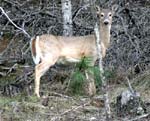 | | Deer near Potlatch |
Crane and his grandmother don't live far from the village. He's a great hunter! The people are having a tough time and the chief sends his daughters to Crane. Upon their arrival Little Squirrel and Chipmunk are fed well and each day during their stay Crane hunts and brings home two deer. After some time, he says to the girls, it's time to return to their family. He packs all the meat into a bundle and puts it under his belt, and they return to the chief's village. As the meat is laid out on a big tule mat it expands so there is enough venison to feed all the people! After the people are cared for, Crane returns home. When Crane hunts he only hunts two tsi'i' (deer) at a time. But when Coyote hunts, he tries to take as many as he can, but only gets two small fawns. The people always laugh at Coyote. (Abbreviated from Frey, Landscape Traveled by Coyote and Crane, University of Washington Press, 2001:3-5; originally told by Dorothy Nicodemus in 1927, Lawrence's grandmother.)
It was Crane who established the way of the hunter. Whenever there is a need in the family and community, for example, when someone is sick or aged and cannot provide for himself, or there is a birthday celebration for a grandmother or a funeral and wake for her, designated hunters will go out and hunt deer and elk to meet the needs of the family. There is no thought to hunt for themselves or to sell the hides and meat for profit. The meat of the deer is only offered to the hunter by that Animal Person so that it can be shared with those in need.
|
|
Deer and a moose, seen at the south end of the Coeur d'Alene Reservation, along side the busy Highway 95. (filmed and edited by Rodney Frey, August 2002)
|
Among the animals hunted were the White-tail deer (Odocoileus virginianus), Mule deer (Odocoileus hemionus),
Elk (Cervus canadensis), Moose (Alces alces),
Black bear (Ursus americanus) and Porcupine (Erethizon dorsatum). One common method of deer hunting, unique to the Schitsu'umsh involved the use of dogs or designated "drivers" who would herd the deer into a water crossing or lake shore. There the hunters from their canoes could spear or shoot with bow and arrow the oncoming animals rather easily. Hunting bows rather short, sinewed-back, made of dogwood or syringa, with amazing strength. Arrows were up to three feet and made of serviceberry wood. The prayers and suumesh songs of hunting headmen would also be given during the hunt to help ensure success. In a single collective hunt as many as 200 deer might be acquired. The meat would then be butchered in a prescribed way, with suumesh songs accompanying each stage. The venison would be distributed to all in the camp, assuring that none went without ample food. Fresh meat was often roasted, with plenty of it dried for later use. The hides were tanned and in high demand by other tribes and exchanged for salmon at the great fishing centers, such as Kettle Falls and Celilo Falls.
© Coeur d'Alene Tribe 2002
< previous |
next >
|








